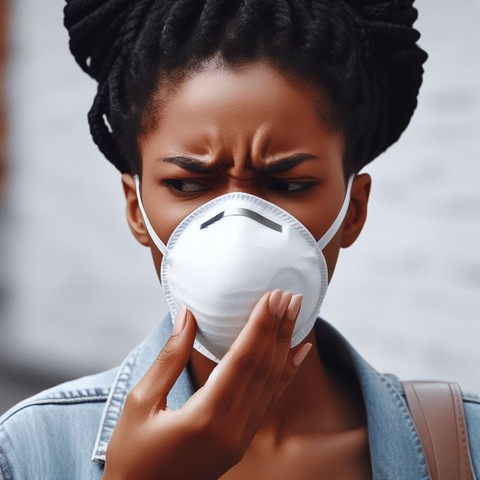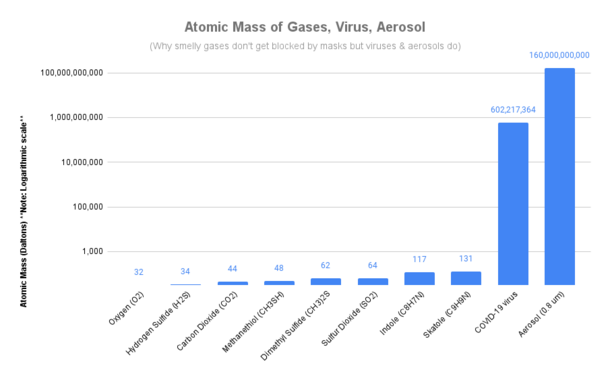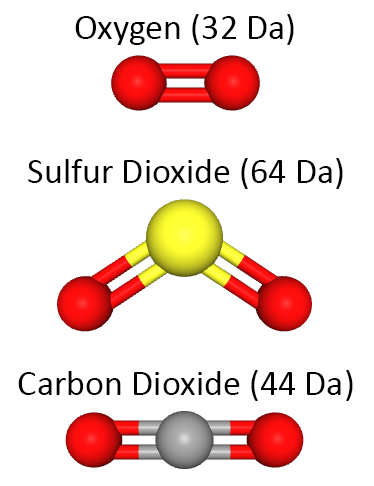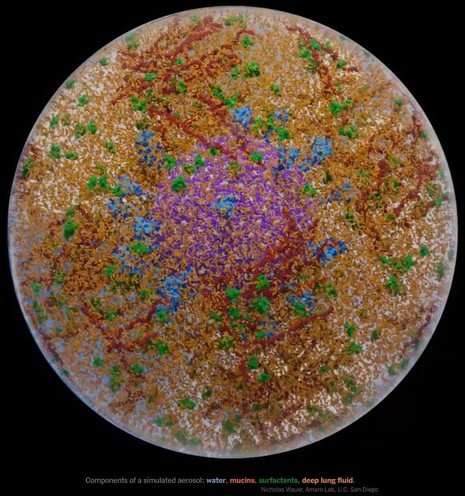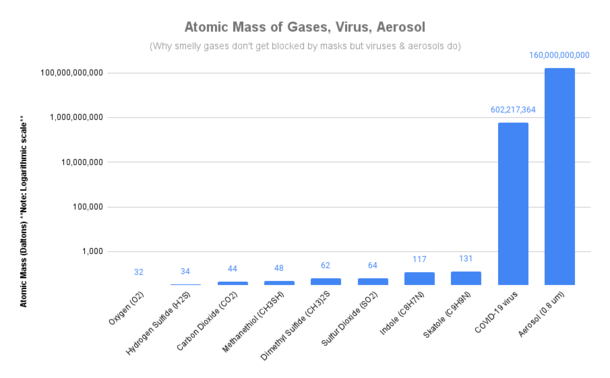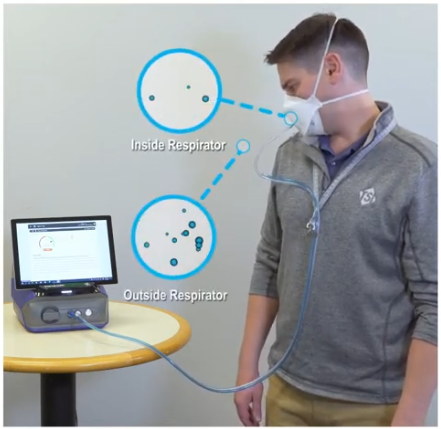Recent searches
Search options
Why can you still smell things wearing an effective #mask?
You can #smell some nasty things like #smoke and rotten eggs even with fit tested #N95 #respirators which block tiny viruses/bacteria because the smell molecules have atomic masses that are 17 million times less than a #virus . 1/
The one page easier to share version of this thread can be found at: https://threadreaderapp.com/thread/1728039593700647259.html
This long thread (with info from @Wikisteff ) explains how molecules detected in our olfactory receptors as smells can pass through material in masks, respirators, and filters (HEPA/MERV-13/CR Boxes) while still blocking tiny particles like viruses and particulate matter. 2/
First, some background information. A dalton (Da) or unified atomic mass unit (u) is commonly used in physics and chemistry to express the mass of atomic-scale objects such as atoms, molecules, and elementary particles ( https://en.wikipedia.org/wiki/Dalton_(unit) ). 3/
Oxygen (O2) that we breathe is 32 Da and carbon dioxide (CO2) that we exhale is 44 Da. Other gases that we smell like hydrogen sulfide (H2S) which smells like rotten eggs is only 34 Da, and sulfur dioxide (SO2) the burning smell after lighting a match is 64 Da. 4/
When you pass gas (fart) the smell comes from a multitude of molecules including:
- Hydrogen Sulfide (H2S) = 34 Da
- Methanethiol (CH3SH)= 48 Da
- Dimethyl Sulfide (CH3)2S = 62 Da
- Indole (C8H7N) = 117 Da
- Skatole (C9H9N) = 131 Da
5/
This is very important to understand because by comparison, a single COVID-19 virus particle (virion) has a mass of 602,217,364 Da or 17 million times more than the rotten egg smelling hydrogen sulfide at 34 Da ( https://www.pnas.org/doi/10.1073/pnas.2024815118 ).
It is estimated that a COVID-19 infected person carries between 1 billion and 100 billion virions during peak infection. 6/
Viruses don't travel on their own through the air, they actually catch rides in aerosols which also contain water, mucins from the lining of the lungs, deep lung fluid and surfactants to make up the complex blob you see in the image ( https://twitter.com/jeffgilchrist/status/1467582905396432904 ). 7/
Multiple studies have found the highest concentration of virus in aerosol particles are in the smaller size ranges which can stay in the air for extended periods of time and lowest concentration in larger droplets that fall to the ground quickly, hence the need for airborne protection. 8/
COVID-19 was detected in aerosol particles ranging in size from 0.34 micrometers (um) to larger than 8.1 um with the highest concentrations found in particle sizes ranging from 0.94 um, to 28.8 um ( https://www.tandfonline.com/doi/full/10.1080/23744235.2022.2140822 ). 9/
@Wikisteff estimates the molecular mass of a 0.8 um largely water based aerosol (which is at the smaller end of the aerosol size spectrum but with highest concentrations of COVID-19 virus) would be approximately 160,000,000,000 (160 billion) Da ( https://www.ncbi.nlm.nih.gov/pmc/articles/PMC9271203/ ). There would also be even larger aerosols than this carrying COVID-19 virus. 10/
You can see from the graph there is a monstrous difference in mass between gases you can smell like hydrogen sulfide (34 Da) and the bare COVID-19 virus (602 million Da) and the aerosols that COVID virus are transported in (160 billion Da). Note the graph is in logarithmic scale so each number on the vertical axis scale is 100x larger than the one below. 11/
We know that people can still breathe while wearing masks and respirators so oxygen (32 Da) and carbon dioxide (44 Da) can pass through the filtering material easily which have similar atomic mass to the smell gases (34 to 131 Da) which can also pass through. 12/
In order for a respirator to be effective at blocking viruses and particulate matter it needs to block particles that are 17 million times larger mass than gas to stop a COVID-19 virus and 4.7 billion times larger mass to stop an aerosol that the virus would be travelling in.
Masks can also reduce some smells and block others all together, it all depends on how the smell molecules arrive; if they are tiny gases on their own or if they are larger particles that get filtered. 13/
So now you know that some smelly gases have a similar mass to oxygen and why they can easily pass through mask/respirator material just like oxygen but can N95 respirators actually filter these million and billion times larger mass particles of viruses and bacteria? Yes!
14/
Scientists and engineers who designed these respirators did actually test them to ensure they did filter viruses and bacteria and even came up with standards for determining the efficiency with real viruses and bacteria. H/T: @ghhughes 15/
Bacterial filtration efficiency (BFE) is tested using the ASTM F2101 standard and multiple tests were conducted in this study using the S. aureus bacteria while viral filtration efficiency (VFE) was tested using the single-stranded DNA virus bacteriophage phiX174 ( https://www.ncbi.nlm.nih.gov/pmc/articles/PMC7157953/ ). 16/
The study found that the N95 respirators they tested filtered more than 99.62% of the bacteria and more than 99.8% of the virus which is much higher than the required 95% filtration needed by the N95 standard to pass. So there you have it, N95 respirators can actually filter viruses and bacteria and are actually tested with a standard to ensure so. 17/
To learn more about how N95 respirators and HEPA/HVAC filters can filter out such small particles like virus aerosols and particulate matter from smoke (does not work like a sieve), see this thread which explains the physics ( https://pingthread.com/thread/1602994049815908353 ). 18/
Ok so we have now confirmed the filtering material itself can filter viruses and bacteria, but what about a respirator on the face of a real person in the real world, does that still work? 19/
Thankfully engineers have also built equipment called a condensation particle counter (CPC) to measure the particles both outside and inside a respirator simultaneously. This testing occurs while the person is wearing the respirator so they can measure exactly how well the respirator is filtering on your face in the real world. 20/
Some of you may have already experienced this through a respirator fit test. You can learn more about how quantitative fit testing with CPC equipment is done in this thread ( https://pingthread.com/thread/1652394034055323648 ). 21/


